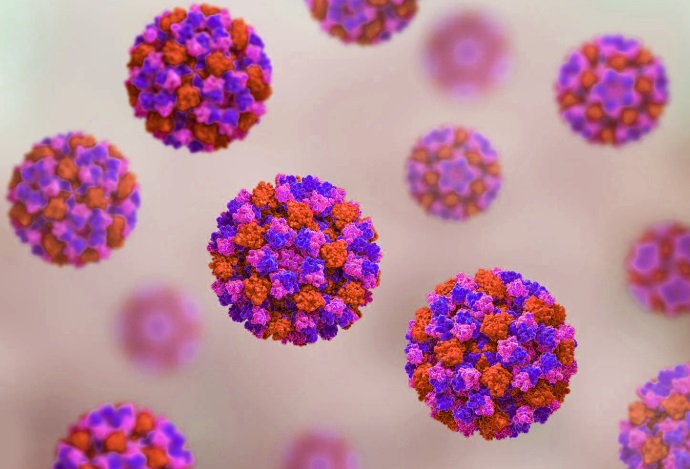Nikhil Prasad Fact checked by:Thailand Medical News Jan 19, 2025 9 months, 2 weeks, 6 days, 8 hours, 16 minutes ago
Medical News: A Silent Threat to Global Health
Norovirus, an RNA virus from the Caliciviridae family, is a leading cause of acute gastroenteritis globally. Affecting people of all ages, it accounts for nearly one-fifth of all gastroenteritis cases worldwide, with approximately 699 million infections reported annually. The United States at the moment is current facing an unprecedented surge of Norovirus infections across the country and it is believed that newer strain of Norovirus such as the GII.17 is behind the rapid spread of the virus.
 Norovirus Can Also Spread Via Aerosol Transmission
Norovirus Can Also Spread Via Aerosol Transmission
Despite its well-known transmission pathways through direct contact, contaminated surfaces, food, and water, a lesser-known but significant mode of transmission has emerged: aerosol transmission. This
Medical News report delves into this underexplored aspect, shedding light on its implications for public health.
Understanding Norovirus Aerosols
Aerosols are tiny particles suspended in the air, which can harbor viruses, bacteria, and other microorganisms. Bioaerosols, specifically, are aerosols that carry biological agents such as norovirus. These particles range in size from 0.1 to 20 micrometers, with those under 5 micrometers remaining airborne for extended periods and easily inhaled into the lower respiratory tract.
Norovirus aerosols are predominantly produced during vomiting and diarrhea episodes in infected individuals. Studies have shown that even minimal exposure to these particles can result in infection, as the virus is highly contagious, with as few as 18 viral particles being sufficient to cause illness.
The Mechanisms of Aerosol Production
Vomiting is a primary source of norovirus aerosols. The act of vomiting generates high-pressure forces that atomize viral-laden liquid into fine particles, which then become airborne. Additionally, contaminated surfaces contribute to aerosolization when mechanical actions, such as mopping, disturb the settled particles. Research has confirmed that aerosolized norovirus particles remain viable and infectious, highlighting the need for rigorous cleaning and ventilation protocols in affected areas.
Diarrhea can also contribute to aerosol transmission, particularly during toilet flushing. Flushing disperses aerosolized particles into the air, potentially contaminating nearby surfaces and increasing the risk of airborne transmission. In public and shared toilets, inadequate sanitation further exacerbates this risk, especially when proper disinfection protocols are not followed.
Real-World Cases of Norovirus Aerosol Transmission
Several documented outbreaks have provided compelling evidence of aerosol transmission. For instance, a hotel restaurant witnessed a significant outbreak linked to a guest vomiting in the dining area. Epidemiological studies revealed a direct correlation between the distance of diners from the vomit site and their likelihood of infection. Similar incidents in schools, hospitals, and cruise ships have demonstrated how aerosolized p
articles can lead to widespread infections, especially in enclosed or semi-enclosed environments.
In one notable case in China, a student’s vomiting episode in a classroom led to an outbreak affecting over 200 individuals. Poor ventilation and delayed disinfection were identified as major contributing factors. Another incident in a kindergarten highlighted how aerosolized particles from a vomit incident were circulated through an air conditioning system, infecting children and staff.
Challenges in Detection and Prevention
Detecting norovirus aerosols remains a significant challenge. Conventional bioaerosol samplers have limitations in efficiency, particularly for capturing submicrometric particles that are most likely to carry viruses. Researchers have developed advanced methods, such as cyclone samplers and liquid impaction systems, to improve detection accuracy. However, these methods are not yet standardized, and the absence of an effective in vitro culture system for norovirus further complicates infectivity assessments.
Prevention requires a multi-faceted approach. Rigorous cleaning protocols, including the use of effective disinfectants, are essential. Ventilation plays a crucial role in reducing the concentration of airborne particles, especially in closed spaces like schools and hospitals. Public awareness campaigns can educate people about the risks of aerosol transmission and the importance of hygiene practices.
Key Study Findings and Implications
The research conducted by scientists from the School of Public Health at China Medical University and the Beijing Center for Disease Prevention and Control underscores the critical role of aerosol transmission in norovirus outbreaks. The study emphasized the high infectivity of aerosolized particles and their ability to remain suspended in the air for extended periods. Key findings include:
-Sources of Aerosols: Vomiting and diarrhea were identified as the primary sources, with activities like mopping and toilet flushing contributing to secondary aerosolization.
-Persistence in the Environment: Norovirus aerosols can remain viable in various settings, including hospitals, wastewater treatment plants, and public restrooms.
-High-Risk Environments: Enclosed spaces with poor ventilation, such as classrooms, nursing homes, and cruise ships, are particularly vulnerable to outbreaks.
-Infectivity Studies: While challenges exist in culturing the virus, alternative methods have confirmed the potential for airborne transmission, necessitating further research and technological advancements.
Moving Forward: Addressing the Knowledge Gaps
Despite these advancements, significant gaps remain in our understanding of norovirus aerosol transmission. Research is needed to:
-Develop standardized sampling and detection methods for viral aerosols.
-Explore the role of saliva and respiratory secretions in aerosolization.
-Investigate the long-term viability of aerosolized particles in different environmental conditions.
-Evaluate the effectiveness of various disinfectants and air filtration systems in mitigating transmission.
Conclusions
The study’s findings highlight the importance of recognizing aerosol transmission as a critical pathway for norovirus outbreaks. This mode of transmission, often overlooked, poses significant challenges for infection control, particularly in high-risk environments. To mitigate the risks, public health strategies must incorporate measures such as improved ventilation, prompt disinfection, and the development of robust detection technologies.
Effective prevention and control require a collaborative effort involving researchers, healthcare professionals, and policymakers. By addressing the knowledge gaps and implementing evidence-based interventions, we can reduce the burden of norovirus and enhance global health resilience.
The study findings were published in the peer-reviewed journal: Viruses.
https://www.mdpi.com/1999-4915/16/1/151
For the latest on Norovirus, keep on logging to Thailand
Medical News.
Read Also:
https://www.thailandmedical.news/news/new-strain-of-norovirus-called-gii-17-behind-current-surge-in-the-united-states
https://www.thailandmedical.news/news/enteric-viruses-and-their-effects-on-human-health
https://www.thailandmedical.news/news/scientists-identify-ten-different-viruses-including-emerging-viruses-causing-gastroenteritis-in-children-during-and-after-the-covid-19-pandemic
https://www.thailandmedical.news/news/ozone-can-be-used-to-destroy-the-new-coronavirus-and-disinfect-areas
